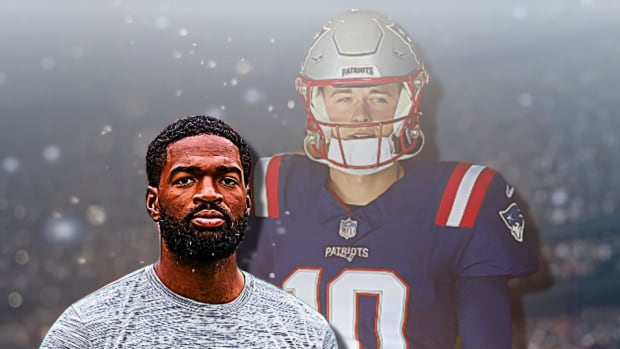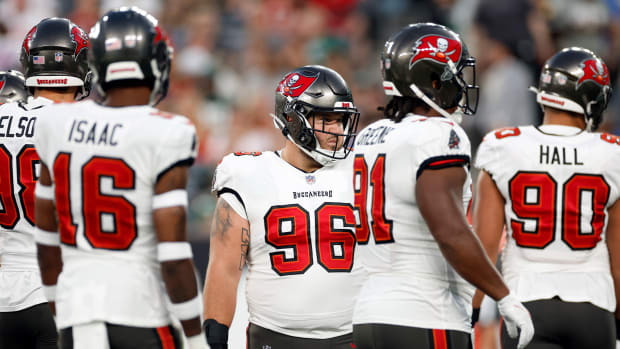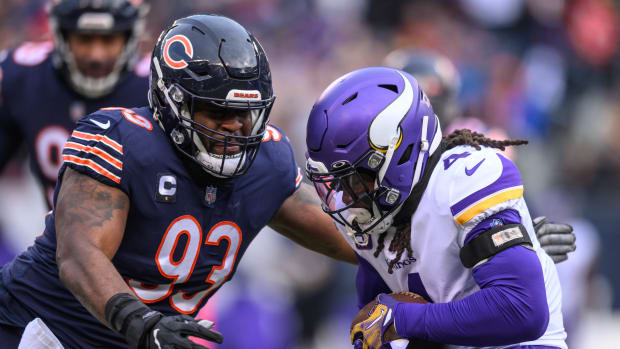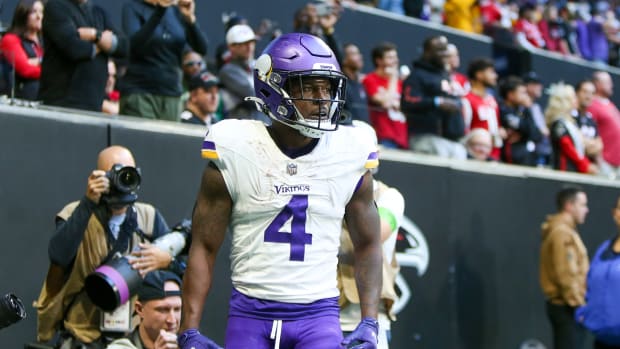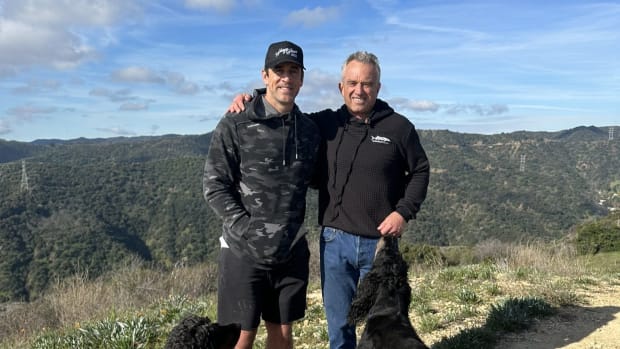What if Geno Smith is not terrible?
Your teams. Your favorite writers. Wherever you want them. Personalize SI with our new App. Install on iOS or Android.
The Jets have spent most of the off-season playing contract chicken with 2015 starting quarterback Ryan Fitzpatrick, who posted career-best numbers of 3,905 yards passing and 31 TDs in his first season as the team’s starter. The consensus all along has been that Fitzpatrick, eventually, would re-sign. He still may, but with the Jets on the brink of training camp there has been no sign of movement regarding the contract talks.
The surprising last-second contract extension for Muhammad Wilkerson is another factor in the mix now—it should give the Jets more money to use in 2016, with Wilkerson off the franchise tag and his signing bonus spread over the life of his contract; however, it cuts heavily into future salary caps.
So, what happens if both sides stand their ground? Are the Jets doomed if Geno Smith has to be the full-time starter?
Nope. Well, maybe not.
It was around this time last year when Smith’s hold on the starting QB job vanished with a punch to the jaw from then teammate IK Enemkpali. Fitzpatrick took over with Smith out and never relinquished the job, nearly guiding the 10–6 Jets to the playoffs. (Granted, to be fair, a handful of Fitzpatrick miscues helped prevent that record from being even better.)
The Jets were primed to head into 2015 with Smith as their quarterback. They sound—grain-of-salt warning siren—satisfied should Fitzpatrick not return for 2016.
“Being in the system a year, he’s light years ahead of where he was last year,” Jets coach Todd Bowles said last month. “As far as being confident, operating the system and understanding the checks and running the offense, he’s night and day where he was.”
Coachspeak? Posturing to make Fitzpatrick think he’s not needed? Perhaps. It’s also possible what Bowles said is true.
Smith is entering his fourth year as a pro, and he hardly has had a lot of stability in years one through three. He was thrown into the fire as a rookie starter in 2013, was part of the wreck of a 2014 season that ended with Rex Ryan’s dismissal and then lost his No. 1 job to Enemkpali’s fist. That injury at least allowed Smith to slow down the wheel, giving him time to take a step back and regroup.
“I think being able to watch the game from afar, watch how the mechanics of the offense work, game-planning throughout the week, the terminology, how to create different things within the offense—that helps out a ton,” Smith said. “Now you know what to do rather than trying to figure out what do, which is what I was doing myself.”
• SI’s best players by position | Outside WRs | Slot WRs | Tight ends
There was some evidence of that maturation during Smith’s brief Week 8 relief appearance for an injured Fitzpatrick last season. The Jets trailed for much of that game in Oakland, so Smith racked up the majority of his 265 passing yards and two touchdowns when the outcome was mostly decided. But amid lingering issues, there were glimmers of hope.
Take this throw to Brandon Marshall, for example.
That’s a dime over Marshall’s outside shoulder for a 28-yard gain. Just one throw, sure, but perhaps an important illustration of what Smith can bring to the table. Fitzpatrick was among the worst QBs in the league last season at throwing the deep ball. This outstanding deep dive into Fitzpatrick’s 2015 season by Edward Gorelik had Fitzpatrick at a 36.4% completion rate on throws of 20-29 yards and 27% on throws of 30-plus yards.
“Geno brings something to the table because he can throw the long ball,” former Jets linebacker and current CBS analyst Bart Scott told NJ.com in July, “so it makes defenses have to step back and play more honestly, defend the entire field, because he can throw the 70-yard bomb on a rope. Fitz has to step into that. He can throw the same route, but he has to let it go earlier, which doesn’t allow the big receivers or the speed of [Eric] Decker to separate. So he has to throw it up, and they have to go get it.”
Smith’s deep-ball numbers from his last extended playing time in 2014 were not much of an improvement on Fitzpatrick’s: 31.3% from 20–29 yards and 38.9% deeper, per Turn on the Jets. The 2014 Jets, though, did not yet have Marshall; Jeremy Kerley finished that year as the team’s second leading receiver, and Percy Harvin was third.
Of greater importance when it comes to judging Smith’s development off a tiny sample size is a play like this.
Smith moves off his initial target in a hurry, doesn’t bail in the face of some pressure starting to come from his blind side and hits Eric Decker in stride. Simple, especially for an NFL-level quarterback, but it’s the type of play Smith too often has failed to make during his career.
The Jets lost this game to the Raiders, 34–20, and there were some typically rough moments along the way for Smith, too. He threw a dangerous incompletion into triple coverage in the end zone, when Kerley was about to come wide open over the middle a split-second later. He tossed up this interception to Charles Woodson, failing to move Woodson off his spot at all before lofting the pass downfield.
The question will be: Can he minimize those moments? Because the hiccups were his undoing in both 2013 (21 interceptions and 55.7% completion rate) and ’14 (a 1:1 TD-to-INT ratio).
Two additional reasons to believe that he might be capable of such a leap: offensive coordinator Chan Gailey and veteran running back Matt Forte.
• Why the Jaguars are set up to have a dominant passing offense
It was no mere coincidence that Fitzpatrick suddenly enjoyed a statistical spike under Gailey’s watch. The Gailey spread scheme paired well with Fitzpatrick’s downfield-deficient style and, in theory, is a terrific match for Smith. While at West Virginia, Smith played himself into the first round within Dana Holgorsen’s Air Raid. Holgorsen liked to test the defense vertically; Gailey often prefers his offense to work horizontally.
Gailey’s approach could help simplify things for Smith, especially now that Forte is joining another dangerous pass-catching back in Bilal Powell. If Smith can take what’s given to him, the Jets’ running backs are capable of turning those simple flare patterns into significant gains.
“I think [Smith has] made giant steps,” Gailey said of Smith earlier this off-season, per NJ.com. “I think he’s right on track for where I’d like him to be. ... Just understanding offense, defense, fronts, coverages, how they go together, thought processes about where to go with the ball. Probably part of it is getting used to our offense, how we call things.”
Gailey also made a simple yet highly effective tweak last season, sliding Eric Decker down into the slot for the majority of his snaps. In doing so, he created a mismatch between the hash marks and gave Fitzpatrick a reliable target to find on intermediate throws. Decker long has been one of the most underrated players in football.
• Fantasy profiles: Melvin Gordon | Which Cards WR should you draft?
Forte unquestionably makes the Jets more versatile, if less powerful than they were with former starter Chris Ivory, who signed with Jacksonville this spring. When Gailey goes to four- and five-receiver sets, Forte and Powell even could be on the field together.
Smith also brings a little extra mobility to the QB spot. Costly fumbles aside, Fitzpatrick was effective as a runner last season, averaging 4.5 yards on 60 attempts, but Smith might give Gailey more of an opportunity to utilize zone reads and designed runs.
And ... O.K., let’s slow down. This all has been rather rosy thus far. Smith was on thin ice headed into 2015, pre-punch, and there is limited proof that he can be a long-term answer at quarterback. Fitzpatrick was a clear upgrade once he took over for an injured Smith, and he would slot back in immediately as the No. 1 should he re-sign.
The Jets were better with Fitzpatrick last year than they would be this without him this year, barring marked improvement on Smith’s end once the games actually begin.
They may not, however, be doomed beyond salvation if Fitzpatrick stays away. Smith has a moderate level of potential within Gailey’s offense, backed by the learning process he sat through from the sidelines last season. He very well might be able to hold down the fort, should the Jets need him to do so.
































